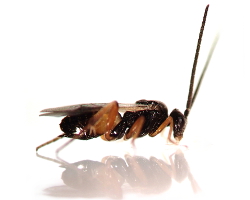Lab Video Productions
Parasitoid Virus. Published on June 27, 2016. Parasitoid wasps are engaged in an evolutionary arms race with their herbivorous hosts. In many ichneumonid and braconid wasps, including Cotesia congregata, parasitoid adaptations to hosts involve species-specific symbiotic polydnaviruses (PDVs) that disrupt host physiology and endocrinology. PDVs are integrated into the wasp genome, produced in the female reproductive system and injected with eggs during oviposition. PDVs modify host immune responses to parasitism via virulent gene expression. In the absence of a functional PDV, parasitoid wasp eggs are encapsulated and killed. This video was produced by Justin Bredlau, Jessica Bray, Kanchan Joshi, and Emily Euto.
Hyperparasitoid Activity. Published on Sep 15, 2014. This video features four hyperparasitoids (Hypopteromalus tabacum, Catolaccus aeneoviridis, Mesochorus americanus, and Isdromas lycaenae) that utilize the braconid Cotesia congregata as a host. It was produced by Justin Bredlau, Jessica Bray, and Megan Ayers.
Parasitoid Activity. Published on Sep 16, 2013. This video shows the life of the parasitic wasp, Cotesia congregata, and two of its hosts. It includes courtship behavior, parasitizing of the host, and larval egression. This video was submitted to the Discovery category of the 2013 ESA YouTube Your Entomology contest.
Kittens and the Blattaria. Published on July 13, 2017. We showcase five species in order Blattodea that we keep in the lab including Blaptica dubia (Dubia cockroach), Nauphoeta cinerea (speckled or lobster cockroach), Blaberus discoidalis (discoid cockroach), Diploptera punctata (Pacific beetle cockroach), Periplaneta australasiae (Australian cockroach), and Gromphadorhina portentosa (Madagascar hissing cockroach). This video was produced by Justin Bredlau and Jessica Bray (narrator).
Insect Net Use Tutorial. Published on Sep 17, 2012. This video is an "old-style" instructional video on insect net use and includes both basic skills and advanced techniques. It was submitted to the Teaching category of the 2012 ESA YouTube Your Entomology contest.

